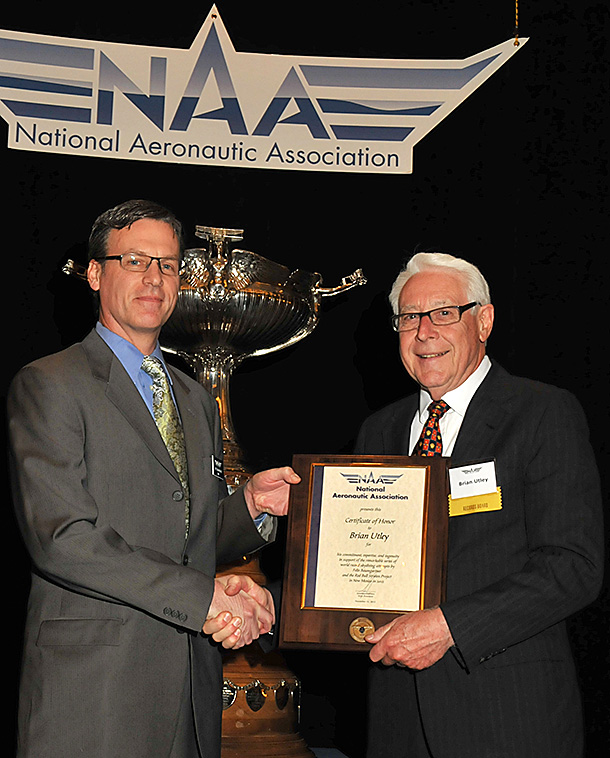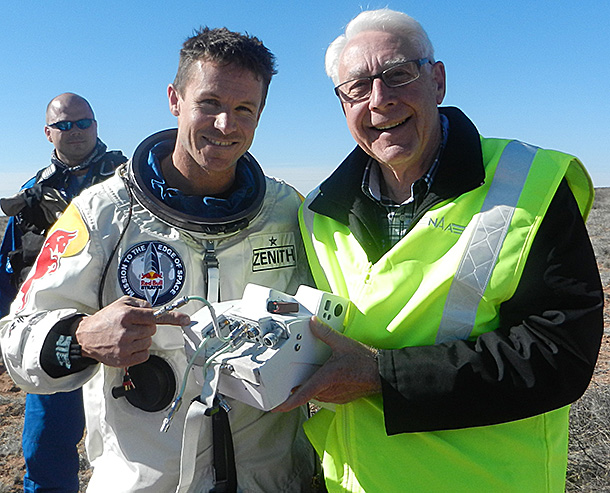From NAA.AERO
 When Felix Baumgartner set a parachuting world record for maximum vertical speed (breaking the sound barrier in the process) on October 14, 2012 from an altitude of 128,100 feet, he had behind him a team that was essential to this dramatic mission. For example, Retired Air Force Colonel Joe Kittinger, who made a jump in 1960 from 102,800 feet, was his adviser and radio link in the mission control center at Roswell Airport.
When Felix Baumgartner set a parachuting world record for maximum vertical speed (breaking the sound barrier in the process) on October 14, 2012 from an altitude of 128,100 feet, he had behind him a team that was essential to this dramatic mission. For example, Retired Air Force Colonel Joe Kittinger, who made a jump in 1960 from 102,800 feet, was his adviser and radio link in the mission control center at Roswell Airport.
Project leader Art Thompson organized a bevy of highly qualified organizations and individuals that built and tested equipment such as the balloon, capsule and spacesuit designed to withstand the rigors of an altitude that no human had ever experienced. Meteorologists monitored and predicted the weather, the flight path and landing zone. Experts from the Air Force conducted the balloon launch, and a medical team was on hand to provide medical care and collect data that will benefit futurespace exploration.
Another critical person operating behind the scenes was Brian Utley, a member of the NAA Contest and Records Board, who served as the official observer of Baumgartner’s skydive on behalf of both NAA and the Fédération Aéronautique Internationale (FAI), which certifies the world record.
Utley is an experienced observer who has overseen dozens of national and world aeronautic records. His role in planning the measurement and certification of this record began three years ago, which was two years before the flights began. “Early in the game Felix said he wanted to be the person to break the sound barrier,” he recalled, and his team worked tirelessly toward that goal.
There were five separate launches – the first two were unmanned to test the balloon, capsule, and operational readiness and to ensure the safety of the launches. “We learned something from each of these,” Utley said. “It allowed me to become much more proficient in evaluating the data and systems as we went along.” These were followed by two record-setting jumps earlier this year in March and July before the final jump in October.
“We accumulated enough data on his body drag from the first two jumps to be able to simulate what velocity he would attain on his free fall,” he explained. The preliminary data from the record-setting skydive indicates that Baumgartner broke the speed of sound at 672 mph at 111,000 ft. He reached his maximum speed of 834 mph at 92,550 which is 1.24 times the speed of sound. Utley pointed out that the speed of sound varies by temperature; at sea level it is approximately 760 mph, but as you rise through the atmosphere and the temperature gets much colder, the speed of sound decreases. For example at -70 degrees centigrade, the speed of sound is 645 mph – a difference of more than 100 mph.
Utley combined two measurements to calculate the data. The first is measurements made by a helium weather balloon that rose to 130,000 feet and radioed the temperature and wind speed as it climbed through the atmosphere, giving him a picture of the temperature all the way up plus being able to predict the drift and landing zone. Second, Baumgartner carried a chest pack with a GPS instrument that gave Utley his precise altitude and direction. It also calibrated time according to Greenwich Mean Time, allowing Utley to create a picture in three dimensions against the time clock and measure the fall as he accelerated second by second.
“There were three times in this flight that I consider the most dramatic,” Utley said. “The first was when the balloon was released and began to float up into the sky. The second is when Felix was standing on the step of the capsule getting ready to jump. It is so high he could see the curvature of the earth and know that there is nothing other than the atmosphere to slow him down as he fell. The third dramatic moment was seeing his parachute open; when we realized it was the main chute with the red side bars and not the plain white emergency chute, we knew Felix had deployed the parachute himself and was safe.”
Utley added, however, that “there are always some problems as you go along – nothing is ever perfect. We had the benefit of having more than one GPS recording device, which allowed me to fill in some gaps in the recording. For example, when he tumbles, the GPS receiver attached to the back of his helmet loses contact with the satellite.”
 At one point during the jump, Baumgartner entered into a dangerous flat spin at a rate of one rotation per second. He did 16 rotations before recovering. “One thing the designers did was mount the chest pack as high on his chest as possible,” Utley noted. “This moved the center of gravity closer to his head so that it reduced the g-forces on his head which, fortunately, were not high enough for him to black out.”
At one point during the jump, Baumgartner entered into a dangerous flat spin at a rate of one rotation per second. He did 16 rotations before recovering. “One thing the designers did was mount the chest pack as high on his chest as possible,” Utley noted. “This moved the center of gravity closer to his head so that it reduced the g-forces on his head which, fortunately, were not high enough for him to black out.”
Utley was in the retrieve helicopter in order to insure the integrity of the flight data and was among the first to greet Baumgartner when he landed. He witnessed Baumgartner raise his arms in thanks for a successful jump and reports that Baumgartner, when asked if he would do it again, said he “would be happy to go back to just being an ordinary helicopter pilot.”
NAA recognized Brian’s remarkable contributions recently at its Fall Awards Banquet when Contest and Records Director, Art Greenfield, presented him with NAA’s Certificate of Honor.